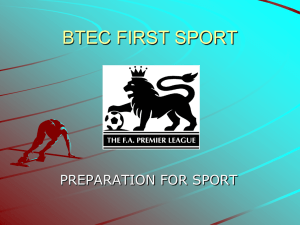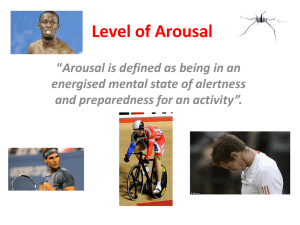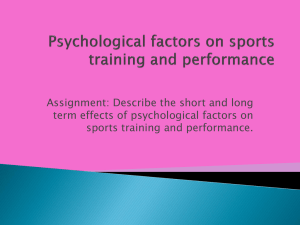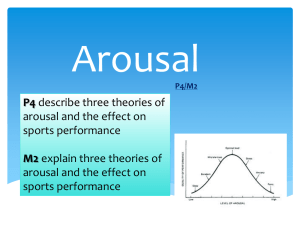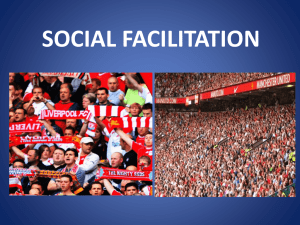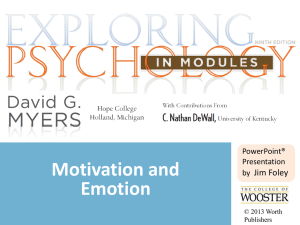PE A2 Psychology of Sport revision guide
advertisement
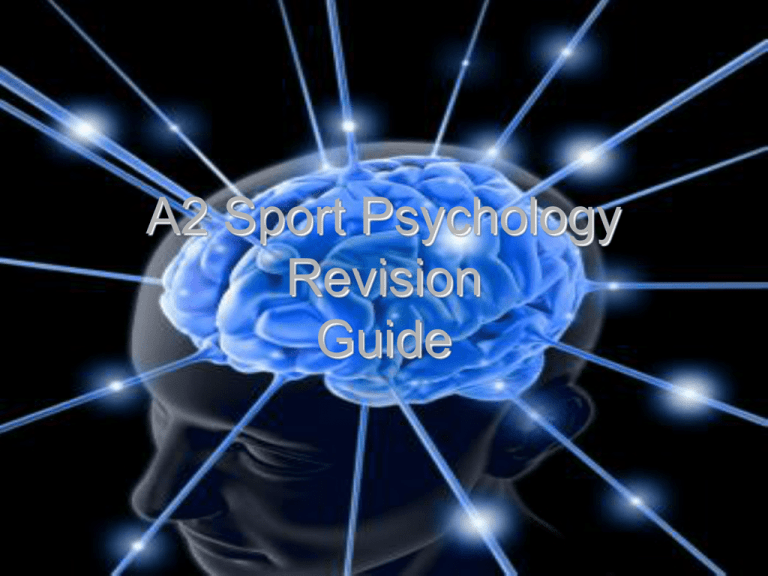
A2 Sport Psychology Revision Guide Sport Psychology Individual Aspects of Sport Performance Group Dynamics Mental Preparation for Sport Performance Competition Effects Consequences of Sport Performance Individual Aspects of Sport Performance Personality Attitude Motivation Personality • Inherited • Stable • Enduring • e.g Eyensenk Interactionist Theories Trait Theories Social Learning Theories. • Learned • Unstable • Environment • e.g Bandura ‘Personality is the sum total of an individual’s characteristics which make him or her unique’ (Hollander) Cattells 16PF (Trait Theory) 16 Personality Factors Questionnaire. Answering a series of questions on a scale of 1-5 on how much you agree with a statement. Eysenck (Trait Theory) Eysenck proposed that only two factors were necessary to explain individual differences in personality. He argued that Cattell's model contained too many factors which were similar to each other, and that a simple two factor model could encompass the 16 traits proposed by Cattell. This model had the following dimensions: Extrovert – Lively, outgoing, sociable, expressive. Introvert – Quiet, independent, private. Stable – Calm, controlled. Unstable (Neurotic) – Anxious, worried. Personality Types (Trait Theory) Leading on from Eysenck, two distinct personality types were identified. TYPE A •characterised by : •impatience •works at a rapid pace •higher levels of stress •easily aroused •strong desire to succeed •anxiety in stressful situations •has a need to be in control TYPE B characterised by : •relaxed and patient •allow time for tasks to be completed •tolerance of others’ mistakes •delegates easily •low personal stress •calm and unflappable in most situations •less competitive Concentric Ring Theory PSYCHOLOGICAL CORE beliefs and values that remain more or less permanent example : a sportsman’s belief that fair play underlies his attitude on the field of play TYPICAL RESPONSES • the way in which an individual responds in certain situations example : Not arguing with the ref. ROLE RELATED BEHAVIOUR in other situations we may behave differently example : Getting frustrated during a game and arguing with the ref. SOCIAL ENVIRONMENT how the behaviour and expectations of others affect our role example : a player argues with the referee because others have done so and got away with it before Psychodynamic Theory Fullfill the ID (Steal Food/ Fight) The EGO The SUPEREGO The ID The Basic Instinct (Hunger/Anger) The moral Arm Stealing and Fighting Are Wrong. Social Learning Theory SOCIALISATION sport has a socialising effect participation in sport establishes norms and values of our society BANDURA behaviour is determined by the situation social comparison behaving the same way as SOCIAL LEARNING THEORY the peer group explains behaviour in terms of the social approval or disapproval reaction to specific situations determines our responses we learn to dea with situations by behaviour is reinforced or observing others penalised or by observing the results of our own VICARIOUS CONDITIONING behaviour on others and by modelling our own behaviour the learning of emotional responses through observational on what we have seen learning athletes learn behaviour by learning to become angry after a watching others valid referee decision has gone against him / her by watching other players do the same Interactionist Theory Personality is a combination of both genetically inheritted traits and learned behaviour. • Somebody who is born with outgoing, aggressive and hot-headed personality characteristics may learn to control and modify them to be more controlled and less aggressive in their personality. – Parental discipline when a child misbehaves, negative reinforcement from peers. • Somebody who is born with more introverted and quiet personality traits may develop a more open and extroverted personality through the environment that they are brought up in. – Lots of interaction with other people, opportunity to play sports and join teams. MEASUREMENT OF PERSONALITY INTERVIEWS QUESTIONNAIRES OBSERVATION before or after the before or after the made during an actual event event event not directly related to not directly related to directly related to performance performance performance open ended and rigidly and varies according to the flexible systematically set out competitive nature of the difficult to quantify able to quantify event accurately accurately difficult to quantify may be influenced by would not be accurately the interviewer influenced by another may be influenced by the demand characteristics can be used to assess observer’s views and specific traits attitudes demand characteristics Demand characteristics refers to an experiment where participants form an interpretation of the experiment's purpose and unconsciously change their behavior accordingly Limitations of Personality Profiling • Not always an accurate predictor of type of activity undertaken. • Extroverts – will enjoy individual sports, • Introverts will play team games. •Not always an accurate predictor of levels of success in sport. Damn it! Attitudes ATTITUDES a combination of beliefs and feelings about : objects people situations (called attitude objects) this predisposes us to behave in a certain way towards them learned or organised through experience evaluative they lead us to think and behave positively or negatively about an attitude object tend to be deep seated and enduring but can change or be changed FORMATION OF ATTITUDES Past Experiences Family Where do our attitudes come from? Peers Media Teachers/Coaches COMPONENTS OF ATTITUDE THE TRIADIC MODEL Cognitive (Knowledge/Beliefs) Going to the gym will get you fit. I enjoy going to the gym I go to the gym twice a week. Affective Behavioural (feelings/emotions) (Intended behavior) PREJUDICE AND SPORT STEREOTYPES PREJUDICE a prejudgement of a person, group, or situation usually based on inadequate information or inaccurate or biased information which reinforces stereotypes example : women are often excluded from male dominated sports clubs or events NEGATIVE STEREOTYPES women in strength, endurance and contact sports participation of particular ethnic groups in specific sports or positions within teams participation of the disabled in physical activity older age groups interest and ability at sport Positive Prejudice = my opponent will be quick at running because he is black. Negative Prejudice = She can’t play football because she is a girl. POSITIVE AND NEGATIVE ATTITUDES TO SPORT POSITIVE ATTITUDE has a positive physical selfconcept satisfaction from participation in sport believe sport promotes health success at sport willing to try new activities encouraged by significant others participates regularly opportunity to participate NEGATIVE ATTITUDES had negative experiences at sport have lifestyle which makes regular sport difficult find sport frustrating lack encouragement unlikely to participate in sport have a negative self concept find sport boring Changing Attitudes Persuasive Communication: Cognitive Dissonance: Changing attitudes through the process of persuasion. If a person holds 2 ideas that oppose & conflict with each other an element of discomfort arises. The persuader needs to be significant & have high status. The message needs to be presented in a way that makes the recipient want to change attitude. The recipients needs to want to change their attitude The situation has to be right – attitudes are easier to change if others are present. This emotional discomfort is called dissonance. e.g. You want to join the gym but don’t think you have enough time Changing one aspect of the triadic model can change your attitude. e.g. – You get a better understanding of the health benefits of joining the gym and make time in your life to attend twice a week. Motivation Extrinsic Intrinsic • Competence • Mastery • Feeling good. Motivation “Drive to succeed” • Praise/Critisism • Fame • Trophies/Medals • Money • Pace Points Achievement Motivation ACHIEVEMENT MOTIVATION the drive to achieve success for its own sake related to Competitiveness (sport specific) persistence striving for perfection influenced by personality factors need to achieve need to avoid failure situational factors probability of success incentive value of success NEED TO ACHIEVE (NACH) Tendency to approach success (TAS) this personality type likes a challenge (approach behaviour) is not afraid of failure has high task persistence Attribute success to internal factors NEED TO AVOID FAILURE (NAF) Tendency to avoid failure (TAF) this personality type avoids challenges (avoidance behaviour) does not take risks often gives up Attribute success to external factors. Achievement Motivation A = TAS someone with a high need to achieve will probably have a low need to avoid failure will choose difficult or demanding tasks which are more risky the hard route up a rock face B = TAF someone with a high ne to avoid failure will probably have a low need to achieve will choose tasks which are less risky and more easily achieved the easy route up the rock face Incentive Value (Achievement Motivation) A= probability of success low (competing against the world champion) therefore strive very hard to win (incentive high) (will be highly chuffed if win) B= probability of sucess high (competing in local club match) therefore don’t need to try as hard to win (incentive low) (and expect to win easily) (not so pleasing) Group Dynamics Groups and Teams Leadership What is A Group? 2 or more people Mutual awareness Interacting with each other Common goal or purpose. ENVIRONMENTAL factors binding members to a team contracts, location, age, eligibility avoid star system, provide opportunities for socialising PERSONAL factors which members believe are important motives for taking part give opportunities for motives to be realised develop ownership feelings and social groupings within the team Cohesion LEADERSHIP the behaviour of leaders and coaches coaches should use all leadership behaviours to influence different individuals TEAM factors relating to the group team identity, targets, member ability and creation of team short and long-term goals rewarding of individual and team efforts Steiner’s Model of Group Performance Actual productivity = Potential productivity - Losses due to faulty processes. Potential productivity is primarily decided by the individual skill levels of team members, Faulty Processes are either Motivational Loses or Co-ordination Loses. Motivational Loses (Social Loafing) Motivational Problems People seem to work less hard in a group than they do on their own Example : in rowing, times of winning double sculls are often only slightly faster than single sculls This is social loafing ‘the Ringlemann Effect’ Why? Individuals may not share the same motives, this leads to loss of group cohesion can hide their lack of effort amongst the effort of other group members Performers are not recognised for their contribution to the team. Example : some players may play a game for social reasons, others in order to win/or What can a coach do? Loafing can be eliminated if the contribution of an individual can be identified Setting specific and measurable goals Recording individual data/statitics – passes/shots etc Co-Ordination Losses Co-ordination losses is depended on how players on the pitch co-ordinate their movement and decision making with each other. Factors that affect it include; The number or players on the pitch. if one player is being selfish or aggressive if a defence is not working together The greater the task cohesion and understanding of each others roles there is between players, the less the losses dues to co-ordination. Practice makes Perfect! Leadership Leaders can influence the behaviour of others towards required goals will influence effective team cohesion will help fulfil expectations of a team develops an environment in which a group is motivated rewarded and helped towards its common goals Where do leaders come from? • emergent leaders come from within a group because of their skill and abilities or through nomination / election • prescribed leaders are appointed by an agency outside the group Characteristics of a good leader • Empathetic • Experienced • Committed • Communication Skills Leadership Theories The ‘great man’ theory (trait) NATURE leaders are born not made leaders have relevant innate personality qualities Social learning theory NURTURE leaders learn their skills through watching and imitating models leaders are formed throughout life by social or environmental influences observation of a model high status of a model imitation or copying of behaviour Was Martin Johnson born to be a great leader or did he learn the necessary qualities? Or was it a combination of the two? (Interactionist) Leadership Styles Three different types of leadership styles have been identified. Autocratic (Task) Orientated – makes all the decisions. Democratic (Social) Orientated – shares the decisions with members of the group, seeks advice and is prepared to change his/her mind. Laissez Faire – lets others make decisions. Each type of leader can be effective in different situations. Fiedler’s Contingency Model Fiedler's model assumes that group performance depends on: Leadership style and Situational favourableness determined by three factors: 1. Leader-member relations - Degree to which a leader is accepted and supported by the group members. 2. Task structure - Extent to which the task is structured and defined, with clear goals and procedures. (facilities/equipment/weather/support) 3. Position power - The ability of a leader to control subordinates through reward and punishment. High levels of these three factors give the most favourable situation, low levels, the least favourable. Democratic (Relationship-motivated) leaders are most effective in moderately favourable situations. Autocratic (Task-motivated) leaders are most effective at either end of the scale. Fiedler suggests that it may be easier for leaders to change their situation to achieve effectiveness, rather than change their leadership style. Chellandurai’s Mutli-Dimensional Model of Leadership Member Characteristics Preferred (Leader) Behaviour Leader Characteristics Actual (Leader) Behaviour Situational Characteristics Required (Leader) Behaviour Satisfaction/Performance Mental Preparation for Sports Performance Commitment (Self) Confidence Concentration (Emotional) Control Goal Setting Effective goal setting is a useful tool that can be used to manage anxiety (control), raise motivation and therefore commitment levels and develop self confidence of the performer. Goals can be either Process – Technique Performance – Time Product – Position And… Mastery/Task – Self improvement Ego/Ability – comparison with others Socially approved. – Seeking social reinforcement. Specific Measurable Accepted Realistic Time Phased Exciting Recorded Goals should be progressive from short to long term. Short Term Medium Term Long Term Self Confidence A generic belief that one can succeed. A situational specific form of self-confidence. Self-Confidence Self-Efficacy An attitude The perception of an ability to perform a particular sporting task Bandura Performance Efficacy Expectation Emotional Vicarious Verbal Previous Arousal Experiences Persuasion Accomplishments consist of what has been observed in others performing a similar skill example : observing another player in your team dribbling a soccer ball, if the model is of similar age / ability and is successful then this may lead to greater self-efficacy encouragement can lead to greater selfefficacy if the person giving encouragement is of high status compared with the performer consist of past experiences example : previously performed skill at dribbling a soccer ball if this is successful then this leads to greater self-efficacy at this particular task in the future if arousal is too high state anxiety - Astate this could lead to low self-efficacy mental rehearsal / physical relaxation could lead to greater confidence and a calmer approach SELF-CONFIDENCE Confidence arouses positive emotions allows the athlete to remain calm under pressure facilitates concentration enables focus on the important aspects of a task enables the setting of challenging but realistic goals increases effort affects game strategies a confident player plays to win even if it means taking risks affects psychological momentum a confident athlete take each point or pla a time and never gives up even when defeat is imminent VEALEY’s MODEL OF SPORT CONFIDENCE trait sport confidence the usual level of selfconfidence example :a footballer is confident in his shooting ability. Sports Confidence competitive orientation the perceived opportunity to achieve a sport performance Type of goals you set. example : the footballer is motivated to play well in the cup final. state sport confidence the level of self confidence related to a specific situation example :a footballer has low state confidence in taking a penalty in the cup final. Concentration Involves focusing attention onto the relevant environmental cues maintaining attention focus until the skill has been completed. Arousal is linked to concentration. When arousal is low, the perceptual field widens taking in too much information for information processing system to deal with. Selective attention is not in operation & concentration on relevant information is difficult. Information overload occurs & decision-making is impeded causing mistakes in performance. As arousal increases, the perceptual field adjusts to the ideal width enabling the performer to focus on the most relevant information. Selective attention is fully operational allowing selective attention to occur. Awareness Cue Utilisation Easterbrook states that an increase of arousal leads to a decrease in number of cues that can be utilised. Cues can be used by the sportsperson •to direct attention •to trigger appropriate arousal responses •to enable attentional focus at a relevant moment •sometimes, narrowing of attentional focus by an aroused player will cause lack of awareness of broader play issues ATTENTIONAL STYLES (Nideffer) INTERNAL/NARROW - A the player decides to concentrate on his own technique INTERNAL/BROAD - B the player focuses on the team tactics given by the coach before a game. EXTERNAL/BROAD - C a player concentrates on the whole game all players’ positions and movements open skills EXTERNAL/NARROW - D the player concentrates on one aspect of the game the goalkeeper closed skills Emotional Control Activation – a state of readiness to perform. Arousal - a state of mental and physical preparedness for action this is the level of inner drives which forces the sportsperson to strive to achieve it needs to be under control and at the right level depending on the task and facilitates the ability to focus (concentrate) Extroverts, Skilful performers and simple tasks require higher levels of arousal. Anxiety – an emotional state similar to fear associated with; physiological (somatic) arousal psychological (cognitive) arousal Can be both State and Trait AROUSAL AND DRIVE THEORY DRIVE THEORY the higher the arousal level the higher the achievement / performance level the more likely that a welllearned skill (a dominant response) will be produced Increased Arousal Expert Increased in Performance Novice Decrease in Performance WITH INCREASED AROUSAL the dominant habit / most usual behaviour will be reproduced a poorly-learned skill will give a performance full of mistakes a well-learned skill will give a skilled performance INVERTED U THEORY INVERTED U THEORY there is an optimum arousal level if aroused more than this performance will decline THE POSITION OF OPTIMUM AROUSAL DEPENDS ON type of activity / task complexity gross skills (weight lifting) require high arousal fine skills (snooker) require low arousal skill level of the performer the more skilful the performer the higher the optimum arousal could be personality of the performer the more extrovert the performer the higher the arousal likely for optimum performance whereas introverts would optimise performance at lower arousal levels EFFECT OF STRESS ON PERFORMANCE INHIBITION inhibition of performance PERFORMANCE OF SKILLS stress may act directly on the information processing of skill motor elements of skill are performed less well muscles tense muscular control is reduced CONCENTRATION concentration is difficult span of attention is narrowed STRESS awareness of being under stress itself acts as a stressor Peak Flow Experience Flow state is attained when the performer has a balanced perception of the demands of the situation & his/her ability to cope. Low Cognitive Arousal When this happens the athlete assumes control over all internal & environmental variables & a time of great happiness & self-fulfilment is experienced. High Somatic Arousal Excitement Peak Flow Happiness Anger Relaxed Drowsiness Bored Fatigue Anxiety Low Somatic Arousal High Cognitive Arousal Individual Zone of Optimal Fuctioning (Hanin) Top athletes have different ZOF. Optimal level of arousal does not always occur at the mid point of the arousal continuum. Optimal level of arousal is not a single point but a band width. Teachers and coaches need to be aware of their performer’s ZOF and work towards this. 0 Characteristics of being in the zone: Performance appears effortless & automatic with athlete feeling in full control; attention & concentration is focused; the execution of the skill brings enjoyment & satisfaction. Anxiety ‘Anxiety occurs when there is a substantial inbalance between the individual’s perception of their ability & their perception of the demands & importance of the situation.’ Speilberger identified both trait and state anxiety. He measured them using simple aquestionaire. Called the State-Trait-Anxiety-Inventory (STAI) A similar test Sports Competition Anxiety Test (SCAT)was later devised to specifically look at the affect competition has on anxiety. 1 2 3 4 Not At All Somewhat Moderately So Very Much So A. I feel at ease 1 2 3 4 B. I feel upset 1 2 3 4 2 3 4 Sometimes Often Almost Always 1 Almost Never A. I am a steady person 1 2 3 4 B. I lack self-confidence 1 2 3 4 Questions are asked about current feelings (state) and general feelings (trait) a score out of 80 is given. Anxiety Management Different methods can be used to reduce anxiety (and arousal levels) these include both somatic and cognitive techniques. These can be used to improve performance, improve focus (selective attention), increase self confidence and reduce the risk of aggression. Cognitive Somatic • Mental Rehersal • Progressive Muscular Relaxation • Imagery • Positive Self Talk • Thought Stopping • Rational Thinking • Biofeedback Competition Effects Social Facilitation Aggression Social Facilitation Social facilitation looks at the effect a crowd (other people watching) has on a players performance. When a player knows they are being watched it can have either positive or negative results. Social Inhibition – the negative effects an audience has on performance Social Facilitation – the positive effect an audience has on performance Immediate effect of an audience is to: •Increase the arousal level of a performer •Increases speed of performance •Releases energy •Arouses competitive drive Dominant Response (Social Facilitation) Dominant Response Zajonc believed that the ‘mere presence’ of others is sufficient to increase arousal. He used drive theory to link the relationship between arousal and performance. However, the quality of the performance depends on how well the skill has been learned. Our ‘learned behaviours’ tend to be our dominant responses. A dominant response is the behaviour most likely to occur when we are pressured to respond. As arousal increases we are more likely to see our dominant responses. If you’re at the autonomous stage of learning, your dominant response is most likely to be the correct action but if you’re at the associative phase of learning you are more likely to show incorrect response. Arousal Evaluation Apprehension The Evaluation Apprehension Theory was proposed by Cottrell. He argued that we quickly learn that social rewards and punishments that we receive from other people are based on their evaluations of us. When we find ourselves with a social presence, we will experience an acquired arousal based on evaluation apprehension. In other words, performance will be enhanced or impaired only in the presence of persons who can approve or disapprove the performance. Audience Effects Homefield advantage - Large supportive crowds are said to help the home team. Most evident in indoor sports. Proximity Effect - Crowds that are close to the action eg. basketball/ice hockey are said to increase audience influence. Distraction Effect – The above can cause players to lose focus and become distracted from their performance. As a result Information Processing is inhibited. Wrong decisions can be made. Reaction time may be slowed down. Important cues will be missed. Strategies to Combat Social Inhibition Practice selective attention to cut out awareness of others Cognitive visualisation such as; imagery mental rehearsal Ensure essential skills are over-learned & grooved to ensure dominant response is successful Simulated crowd noises Raise athlete’s awareness of ZOF Incorporate stress management into training Appropriate use of attribution to raise confidence Aggression ‘Any behaviour that is intended to harm another individual by physical or verbal means.’ Differences between aggression & assertion. Aggression – intent to harm Assertion – within the rules 3 types of aggression: Hostile (or reactive) Aggression: Prime motive is the intent to harm or injury. Outside the rules of the game. Involves anger. Instrumental (or channelled) Aggression: Within the rules and although prime motive is successful execution of skill, there is still intent to harm. Anger is not evident. Assertive behaviour: Does not attempt to harm & is within rules & spirit of the game. Described as ‘non-hostile self-protective mastery behaviour. Causes of Aggression Nature of the game (contact/non-contact) Wide division between scores Previous experiences could cause grudges or scores to settle Frustration caused by poor form, opposition & referee’s decisions Hostile crowds Venue – home or away Excessively high arousal levels Extrinsic rewards Theories of Aggression Instinct Theory – Trait Perspective: Aggression is genetically inherit. Social Learning Theory – Social Learning Perspective: Aggression is nurtured through environmental forces. It is learned by watching & copying role models & becomes more acceptable if reinforced. Frustration Aggression Hypothesis - Interactionist Approach: Frustration develops when goal-directed behaviour is blocked. If aggressive act is successful, frustration is released & aggressor feels good & learns that violent strategies are successful. If aggression fails & results in punishment, further frustration is generated. Aggressive Cue Hypothesis (Berkowitz) – Interactionist Approach: Frustration leads to an increase in arousal which sometimes will result in aggression. Aggressive cues such as bats or sticks will trigger aggression if arousal is high. The best players have the ability to control frustration and arousal. Methods to Combat Aggressive Tendancies •Positively reinforce non-aggressive behaviour & negatively reinforce aggressive behaviour •Punish aggressive players •Violent players should be withdrawn from aggressive situations •Stress performance rather than outcome goals •Emphasise non-aggressive role-models •Attribute successful performance to skilfulness •Use cognitive strategies such as rational thinking, self-talk & imagery •Lower arousal levels Consequences of Sport Performance Attribution Theory Attribution Thoery Attribution theory (Weiner) explains how individuals interpret events and how this relates to their thinking, motivation and behavior. External Internal Stable Locus of Causality Ability Task Difficulty Effort Luck Stability Un-Stable Concentration Commitment Control of arousal Confidence Attitude Mental/physical preparation Internal – factors within control of the individual External – factors out of performer’s control Stable – permanent Unstable – temporary & changeable Attribution According to attribution theory, high achievers (TAS) will invite rather than avoid tasks that could lead them to success because they believe success results from high ability and effort, and they are confident of their ability and effort. However, they believe failure is caused by bad luck or things that are beyond their range of control. Failure doesn't affect their selfesteem but success builds pride and confidence. Mastery Orientation On the other hand, low achievers (TAF) avoid success-related actions because they tend to doubt their ability and/or assume success is related to luck or influence or to other factors beyond their control. Even when successful, it isn't as rewarding to the low achiever because he/she doesn't feel responsible. Success does not increase his/her pride and confidence. Learned Helplessness Attribution Retraining Attribution retraining is when low achievers (usually TAF personalities) are taught to alter their perception of why something went wrong or well. • By giving feedback to the performer and analysing why something happened. • The Athlete needs to have control over the situation. • The coach needs to get the performer to attribute a lack of success to internal unstable factors so the athlete has control over the situation & provided the possibility of working through success. This will help to prevent learned helplessness The End
